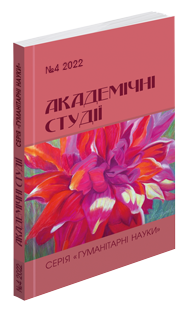Abstract
The article has compared the specifics of neologisms in English and Ukrainian languages. The aim of our study was to establish a comparative relationship between the specifics of neologisms in both languages in the modern Web Media. It has been found out that innovative vocabulary appears during important periods of time (such as Pandemic 2019 and Military Actions in Ukraine 2022). During our theoretical research, analytical review, generalization and concretization have been used as the main methods. Thus, although the problems of neologisms and innovative vocabulary are not one-sided, the analysis of their identification criteria, which exists in modern linguistics, allowed us to determine the main features, based on which the research and classification of neologisms will become easier and clearer, and it will also help to reveal the potential of neologisms more widely. In our opinion, such an indicator as a criterion of time from 5 to 20 years should be attributed to them, it is the period of time that can be defined as a certain period of development of the studied language. The next characteristic of neologisms is the presence of a certain or partial uncharacteristic or atypicality of language norms. Also, it should be noted that one of the features of neologisms usage is the fact that they are used by the majority of native speakers while preserving the connotation of novelty. Taking into account all of the above, we come to the conclusion that neologisms relate to a certain class of words. Neologisms are words or stable phrases that are new in content or form. They retain their connotation of novelty and relevance for a limited period of time. Neologisms have formed semantic, pragmatic and stylistic features and sometimes they can be recorded in the lexicographic literature. Having investigated the issue of neologisms classification, we came to the conclusion that there is no single classification and usually these language units are classified according to different features. Such features include the following: type of linguistic unit, type of denotation, method of formation, conditions of the method of formation, target purpose. Regarding the method of formation, neologisms are divided into borrowings, morphological, phonological and syntactic. In Ukrainian language, the suffix method of creating neologisms is the most frequent, and in English language they are contamination, truncation and conversion.
References
Зацний Ю. А., Янков А. В. Інновації у словниковому складі англійської мови початку ХХІ століття: англо- український словник. Вінниця : Нова Книга, 2008. 360 с.
Кравчук Л. В. Мова мас-медіа як основне джерело збагачення новотворами загальномовного словника Л. В. Кравчук. Іван Огієнко і сучасна наука та освіта. Серія : Історична та філологічна. Кам’янець- Подільський, 2013. Вип. 10. С. 53–58.
Селіванова О. Сучасна лінгвістика: термінологічна енциклопедія. Полтава : Довкілля-К, 2006. 716 с.
Топачевський С. К. Синтаксичні засоби етикетизації англомовного рекламного дискурсy : автореф. дис. … канд. філол. наук : 10.02.04. Харків, 2011. 20 с.
Algeo J., Algeo A. Among the New Words. American Speech. Tuscaloosa, 1994. Vol. 69. № 1. P. 80–90.
Barber C. Linguistic change in present-day English. Edinburgh : Oliver and Boyd, 1964. 154 p.
Reah D. The Language of Newspapers. London : Routledge, 2002. 126 p.
ДЖЕРЕЛА
Мелконян Д. А. Новітні тенденції в системі словоскладання сучасної англійської мови (на матеріалі публіцистичних текстів). URL: http://eprints.zu.edu.ua/18809/1/statia9.pdf (дата звернення: 15.12.2022).
«Українити», «чорнобаїти», «аналоговнєт»: «АрміяInform» зібрала словник воєнних неологізмів. URL: https://detector.media/infospace/article/201285/2022-07-25-ukrainyty-chornobaity-analogovniet-armiyainform-zibralaslovnyk- voiennykh-neologizmiv/ (дата звернення: 15.12.2022).
A Powerful Next-Generation Virtual Events Platform – GEVME. URL: https://www.gevme.com (Last accessed: 15.12.2022).
Neologisms and Social Transformations in the 21st Century: Language as a Driving Force for Societal Changes. URL: https://repository.mruni.eu/handle/007/16498 (Last accessed: 15.12.2022).
Neologisms in Mass Media Language (Using the Examples of Internet Version of Newspaper «Den»). URL: https://science.lpnu.ua/sjs/all-volumes-and-issues/volume-4-number-2020/neologisms-mass-media-language-usingexamples (Last accessed: 20.12.2022).
Shchypachova D. S. Neologism as a linguistic phenomenon in mass media. URL: http://www.kamts1.kpi.ua/sites/ default/files/files/shchypachova_neologism.pdf (Last accessed: 20.12.2022).

